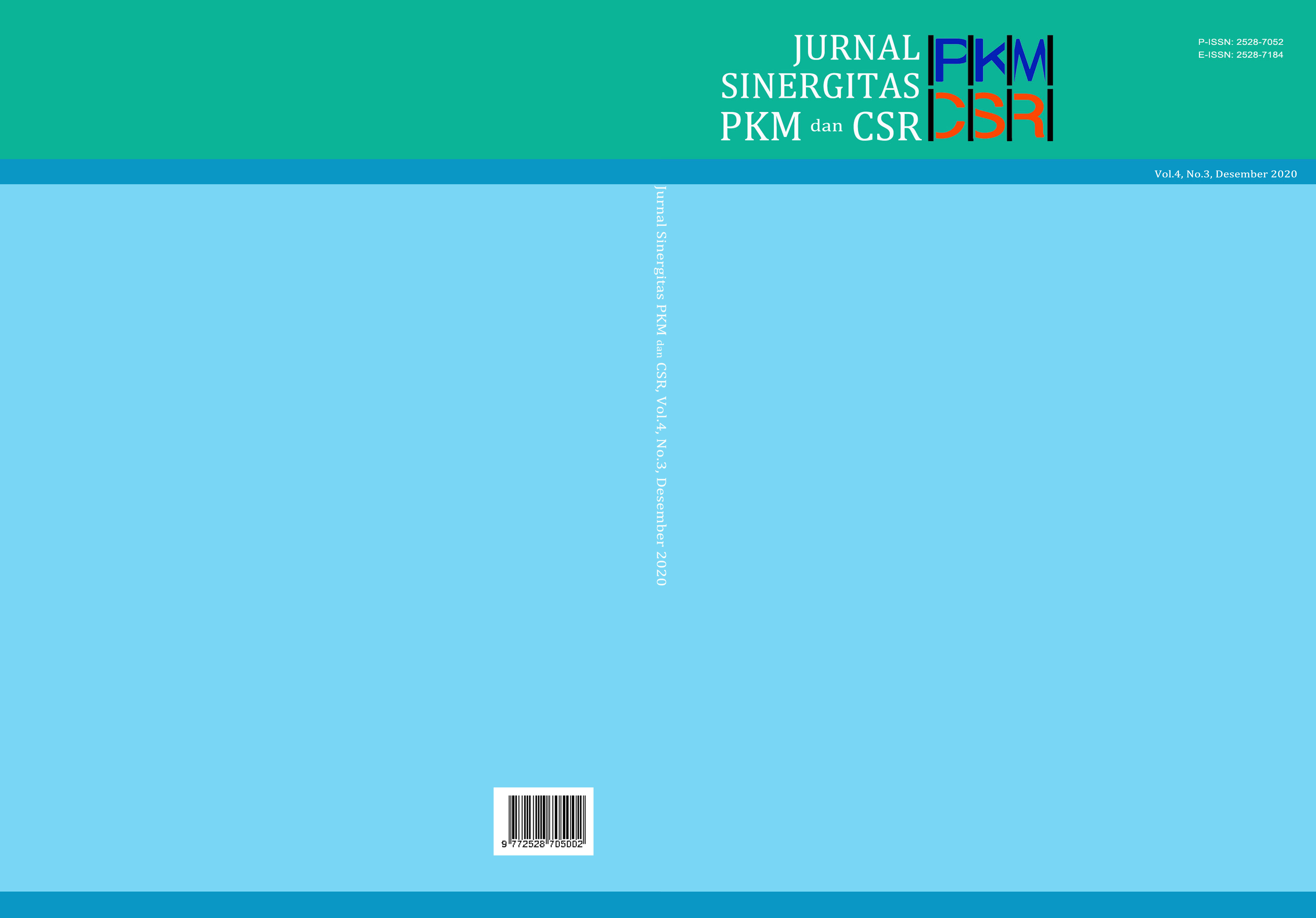UPAYA PENINGKATAN KESADARAN AKAN PELECEHAN SEKSUAL DALAM INDUSTRI MEDIA [RAISING AWARENESS ABOUT SEXUAL HARASSMENT IN THE MEDIA INDUSTRY]
DOI:
https://doi.org/10.19166/jspc.v4i3.2426Λέξεις-κλειδιά:
Sexual harassment, media industry, female journalistsΠερίληψη
The objective of this community service program was to raise awareness about sexual harassment in the workplace, particularly in the media industry. This community service was comprised of two sessions - at Swiss German University and SMK Paramarta, Tangerang. The targeted audiences were:1. High school and university students; 2. Media practitioners. Each session was consisted of the following activities: 1.Movie: “More than Work”; 2. Information session by the Director, Luviana; 3. Panel discussion; 4. Question and answer session; 5. Survey. Prior to the execution of each session, a survey was conducted on those who registered to attend. The purpose was to compare the pre-event results with the post-event results of each session. Results of the post-event A survey showed that 84,6% of respondents felt that they have acquired new knowledge about the media industry; and 84,7% of respondents felt that trough this panel discussion, they’ve become more knowledgeable about sexual harassment. Therefore, it can be concluded that the event A was effective in achieving the objective of this community service. Unfortunately, there was a high discrepancy in the number of respondents of the event B at SMK Paramarta, with 32 students responding to the pre-event survey, and only 7 students responding to the post-event survey. Therefore, the comparison was not valid. However, some results were alarming. This means that there is still a long way to go in the mission to educate the young generation about sexual harassment. Through these findings, it is concluded that a special effort must be made for teenagers.
BAHASA INDONESIA ABSTRACT: Tujuan program pengabdian kepada masyarakat ini adalah untuk meningkatkan kesadaran tentang pelecehan seksual di tempat kerja, terutama di industri media. Pengabdian masyarakat ini terdiri dari dua sesi - di Universitas Swiss German dan SMK Paramarta, Tangerang. Khalayak yang ditargetkan adalah: 1. Siswa sekolah menengah atas dan mahasiswa; 2. Praktisi media. Setiap sesi terdiri dari kegiatan-kegiatan berikut: 1. Film: “More than Work”; 2. Sesi informasi oleh Sutradara, Luviana; 3. Diskusi panel; 4. Sesi tanya jawab; 5. Survei. Sebelum pelaksanaan setiap sesi, survei dilakukan pada mereka yang mendaftar untuk hadir. Tujuannya adalah untuk membandingkan hasil pra-acara dengan hasil pasca-acara dari setiap sesi. Hasil survei pasca-acara A menunjukkan bahwa 84,6% responden merasa telah memperoleh pengetahuan baru tentang industri media; dan 84,7% responden merasa bahwa melalui diskusi panel ini, mereka menjadi lebih berpengetahuan tentang pelecehan seksual. Maka, dapat disimpulkan bahwa acara A efektif dalam mencapai tujuan layanan kepada masyarakat ini. Namun, ada perbedaan yang lebih tinggi dalam jumlah responden pada sesi B di SMK Paramarta, dengan 32 siswa menanggapi survei pra-acara, dan hanya 7 siswa yang menanggapi survei pasca-acara. Karena itu, perbandingan dianggap tidak valid. Namun, beberapa hasil mengkhawatirkan. Ini berarti bahwa jalan masih panjang dalam misi untuk mendidik generasi muda tentang pelecehan seksual. Berdasarkan temuan ini, disimpulkan bahwa diperlukan perhatian khusus bagi kalangan remaja.
Αναφορές
Cela, A. (2015). Sexual Harassment at Work: A European Experience. Academic Journal of Business Administration, Law and Social Sciences, 1(1), 80-91. http://iipccl.org/wp-content/uploads/2015/03/Ajbals-80-91.pdf
Figaro, R. (2018). The World of Work if Female Journalists: Feminism and Professional Discrimination. Brazilian Journalism Research, 14(2), 546-567. https://doi.org/10.25200/bjr.v14n2.2018.1052
Hogh, A., Conway, P. M., Clausen, T., Madsen, I. E. H., & Burr, H. (2016). Unwanted sexual attention at work and long-term sickness absence: A follow-up register-based study. BMC Public Health, 16(1), 678. https://doi.org/10.1186/s12889-016-3336-y
ILO (2011). Guidelines on Sexual Harassment Prevention at the Workplace. https://www.ilo.org/wcmsp5/groups/public/---asia/---ro-bangkok/---ilo-jakarta/documents/publication/wcms_171329.pdf
Komala, R. (2018, July 17). Perlindungan terhadap wartawan: Pekerjaan rumah tanpa akhir. Jurnal Dewan Pers. Retrieved April 15, 2020, from https://dewanpers.or.id/assets/ebook/jurnal/1901200527_Jurnal_Dewan_Pers_edisi17.pdf
Luviana. (2012). Jejak jurnalis perempuan: Pemetaan kondisi kerja jurnalis perempuan di Indonesia. Jakarta, Indonesia: Aliansi Jurnalis Independen.
Muchtar, N., & Masduki (2016). Country Report: Journalists in Indonesia. Worlds of Journalism Study. https://epub.ub.uni-muenchen.de/30120/1/Country_report_Indonesia.pdf
Ramsaroop, A., & Parumasur, S. B. (2007). The prevalence and nature of sexual harassment in the workplace: A model for early identification and effective management thereof. Journal of Industrial Psychology, 33(2), 25-33. https://doi.org/10.4102/sajip.v33i2.374
Sutarso, J. (2012). Perempuan, Kekuasaan dan Media Massa: Sebuah Studi Pustaka. Komuniti, 4(1), 1-17.
Wulandari, C. R. (2016, March 9). Pekerja perempuan di media massa masih banyak alami diskriminasi. Retrieved on April, 15, 2020, from http://www.pikiran-rakyat.com/bandung-raya/2016/03/09/363675/pekerja-perempuan-di-media-massa-masih-banyak-alami-diskriminasi.
Λήψεις
Δημοσιευμένα
Τεύχος
Ενότητα
Άδεια
Authors who publish with this journal agree to the following terms:
1) Authors retain copyright and grant the journal right of first publication with the work simultaneously licensed under a Creative Commons Attribution License (CC-BY-SA 4.0) that allows others to share the work with an acknowledgement of the work's authorship and initial publication in this journal.
2) Authors are able to enter into separate, additional contractual arrangements for the non-exclusive distribution of the journal's published version of the work (e.g., post it to an institutional repository or publish it in a book), with an acknowledgement of its initial publication in this journal.
3) Authors are permitted and encouraged to post their work online (e.g., in institutional repositories or on their website). The final published PDF should be used and bibliographic details that credit the publication in this journal should be included.


